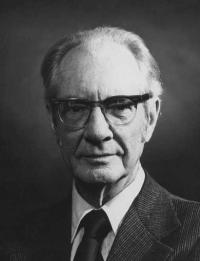1986
Raised on an Iowa farm, Fred Whipple graduated from the University of California, Los Angeles, and then helped compute the first orbit of newly-discovered Pluto while a graduate student under Armin O. Leuschner at the University of California, Berkeley. Whipple worked at Harvard University from 1931 to 1977, and directed the Smithsonian Astrophysical Observatory from 1955 to 1973. He was one of the leaders in the 1973 merger of the SAO with Harvard College Observatory to form the Harvard-Smithsonian Center for Astrophysics (now the Center for Astrophysics | Harvard & Smithsonian) and in the founding of the SAO observatory in Arizona which is now named after him. In the 1930s, using a new, two-station method of photography, Whipple determined meteor trajectories and found that nearly all visible meteors are made up of fragile material from comets, and that none could be shown to come from beyond the solar system. The project also yielded valuable information about the upper atmosphere, and the cameras were later used to track artificial satellites. During World War II he co-invented chaff—aluminum fragments—to foil radar and protect planes. He also invented the "Whipple shield" to protect spacecraft from meteoroids. In 1950 Whipple proposed the “dirty snowball” model for comet nuclei. He suggested that comets have icy cores inside thin insulating layers of dirt, and that jets of material ejected as a result of solar heating were the cause of orbital changes. This model was confirmed in 1986 when spacecraft flew past comet Halley. Whipple’s work on tracking artificial satellites led to improved knowledge of the shape of the earth and greatly improved positions on earth. He proposed and helped organize Operation Moonwatch, in which the public was invited to help track satellites. The discoverer of six comets, Whipple also studied comet rotation and published several books on the solar system. He continued research well into his nineties, serving on the science team of the ill-fated CONTOUR in 2002.
Presentation of Bruce medal
Mercury 15, 139 (1986).
Other awards
American Astronomical Society, Henry Norris Russell Lectureship, 1987.
National Academy of Sciences, J. Lawrence Smith Medal, 1949.
Meteoritical Society, Frederick C. Leonard Memorial Medal,1970, presented by Klaus Keil, Meteoritics 5, 233-34 (1970).
Royal Astronomical Society, Gold medal, 1983, presented by R. Hide, Observatory 103, 189-90.
Biographical materials
DeVorkin, David H., Fred Whipple's Empire: The Smithsonian Astrophysical Observatory, 1955–1973. (Free download)
Levy, David H., “Dr. Comet at 95,” Sky & Telescope, 103, 1, 89-90 (Jan 2002).
Lundquist, Charles A., “Fred L. Whipple, pioneer in the space program,” Acta Astronautica 62, 91-96 (2008).
Smithsonian Astrophysical Observatory
Whipple, Fred L., “Of Comets and Meteors,” Science 289, 728 (2000).
Obituaries
Bernstein, Adam, Washington Post, 1 September 2004, p. B5.
Brownlee, Don & Paul Hodge, Physics Today 58, 3, 86-88 (March 2005).
Chang, Kenneth, New York Times, 31 August 2004, p. C1.
Harvard-Smithsonian Center for Astrophysics, 31 August 2004.
Hughes, David W., Astronomy & Geophysics 45, 6.35 (2004).
Marsden, Brian G., PASP 117, 1452-58 (2005).
Yeomans, Donald K. & Joseph Veverka, Nature 432, 31 (4 Nov 2004).
Yeomans, Donald K., AIP Center for History of Physics (several)
Academic genealogy
Named after him
Minor planet #1940 Whipple
Fred Lawrence Whipple Observatory
Whipple Shield
